North Cyprus – The Must See Attractions!
North Cyprus, also known as the Turkish Republic of Northern Cyprus, is a beautiful and unique destination that offers a variety of attractions and experiences for visitors. Often a place that most visitors of Cyprus do not visit, yet it beholds treasure worthy of anyone’s attention. North Cyprus has beautiful, pristine Caribbean-like beaches with crystal-clear waters and tropical sand. Some famous beaches include Golden Beach, Escape Beach, and Alagadi Turtle Beach. It has a rich and diverse history that dates back thousands of years.
North Cyprus is also famous for its delicious cuisine, a blend of Turkish and Mediterranean flavors. Some popular dishes include lamb kebabs, stuffed vine leaves, and Turkish coffee. Northern Cyprus has a warm Mediterranean climate, with long, hot summers and mild winters. This makes it an ideal destination for year-round travel and tremendously affordable.
Additionally, North Cyprus is home to many ancient ruins and historical sites, including the ancient city of Salamis, the Kyrenia Castle, and the Bellapais Abbey. Let’s look at why you should visit North Cyprus!

This post may contain affiliate links. Please read our disclosure and privacy policy for more information.
Kyrenia Castle, North Cyprus
Kyrenia Castle is a historical castle in the city of Kyrenia, on the northern coast of Cyprus. This castle is one of the island’s most well-known landmarks. It is one of the finest examples of medieval fortification in the Mediterranean. Built by the Byzantines in the 7th century AD. The Lusignans later reinforced the castle in the 13th century. It also has a significant role in the history of Cyprus, serving as a strategic point of defense for the island against invaders. The castle underwent substantial renovations during the Ottoman era. During this time, it was converted into a military barracks. During the British colonial period, it became a prison.
In 1960, following the establishment of the Republic of Cyprus, the castle became a museum. The museum showcases a range of historical artifacts from various periods of Cypriot history. Visitors admire its impressive architecture and learn about the rich history of Cyprus. It remains an important symbol of the island’s cultural heritage and a reminder of its strategic significance throughout the centuries.
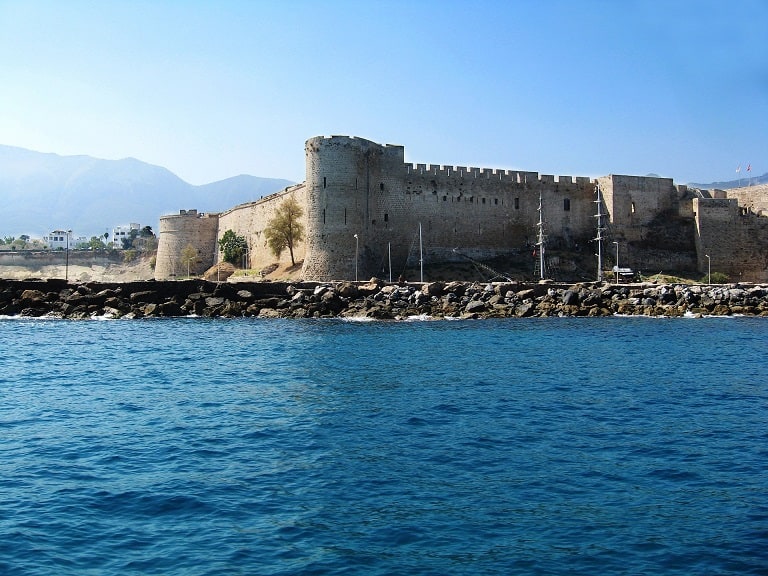
Monastery of Saint Barnabas, North Cyprus
The Monastery of Saint Barnabas is a historic Christian monastery near the city of Famagusta in Northern Cyprus. It is one of the most important religious sites on the island. Dedicated to Saint Barnabas, who is thought to be the founder of the Cypriot Orthodox Church. The monastery was built in the 4th century AD and was renovated and expanded over the centuries. Today, it is a complex of buildings that includes a church, a chapel, a library, a museum, and a gift shop.
One of the most notable features of the monastery is its impressive collection of religious icons, some of which date back to the 16th century. These icons are among the finest examples of Byzantine art in Cyprus.
The monastery is also known for its connection to Saint Barnabas. According to tradition, the saint was laid to rest on the monastery’s site after his martyrdom in Salamis in 61 AD. His tomb was rediscovered in the 5th century, and the monastery was built around it.
Visitors can tour the complex, view the religious artifacts and icons, and learn about the monastery’s history and connection to Saint Barnabas.
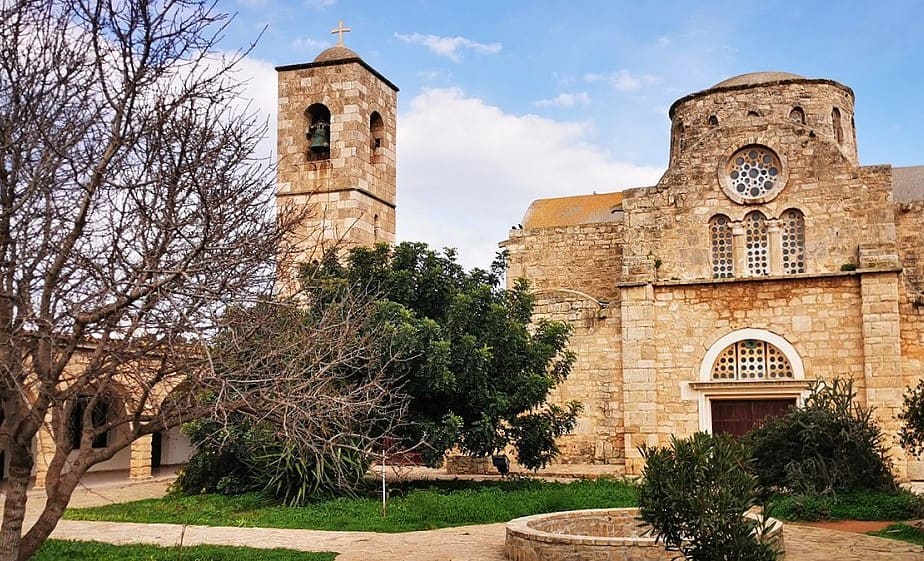
Ancient Shipwreck Museum, Northern Cyprus
The museum houses the remains of a 4th-century BC Greek merchant ship discovered in 1965 by a sponge diver. The vessel was carrying a cargo of over 400 amphorae full of with wine, olives, and almonds when it sank off the coast of Kyrenia.
The museum was established in 1976 and resides in a building once a 16th-century caravanserai. The ship’s hull and cargo, along with other artifacts found at the shipwreck site, are on display in the museum. Visitors can see the ship’s wooden hull. The hull has been preserved using polyethylene glycol (PEG) infusion, and the amphorae and other objects were found on board.
In addition, there are exhibits on the history of seafaring in the Mediterranean and the techniques used by archaeologists to excavate and preserve underwater sites. The museum’s location in Kyrenia, a city with a long maritime history, adds to its appeal. The Ancient Shipwreck Museum in North Cyprus is a fascinating destination for anyone who enjoys archaeology, history, or maritime culture.

Selimiye Mosque, North Cyprus
The Selimiye Mosque, also known as the Cathedral of St. Sophia, is a historical mosque in Nicosia, North Cyprus. It is another of the region’s most impressive examples of Ottoman architecture. The mosque was initially built as a Christian cathedral in the 13th century during the Lusignan period. It was later converted into a mosque by the Ottomans in the 16th century after they captured the island of Cyprus from the Venetians.
The Selimiye Mosque features a large central dome. The central dome gets its support from the four smaller domes and eight massive columns. The mosque’s interior contains intricate carvings and paintings and houses several beautiful stained-glass windows.
Today, the Selimiye Mosque is one of the most popular tourist attractions in North Cyprus.
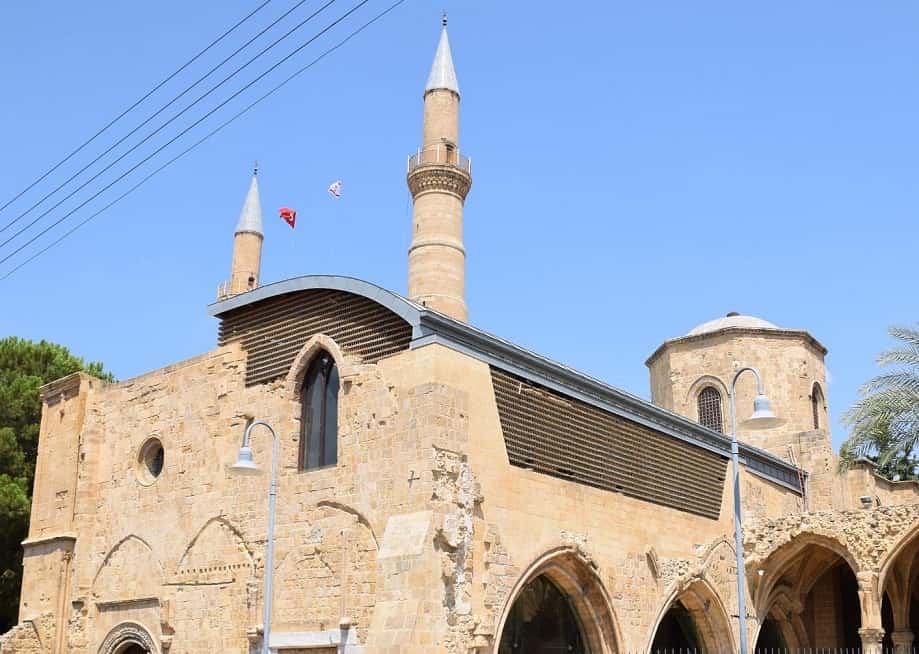
Lala Mustafa Pasha Mosque, North Cyprus
Lala Mustafa Pasha Mosque, also known as the St. Nicholas Cathedral Mosque, is a historic mosque in Famagusta. The French Lusignan dynasty built the mosque as a cathedral in the 14th century. It later became a mosque after the Ottoman Empire captured the city in 1571.
The mosque is named after Lala Mustafa Pasha, a famous Ottoman military commander who led the conquest of Famagusta. The mosque is one of the largest and most significant religious buildings in Northern Cyprus and is a masterpiece of Ottoman architecture.
The mosque’s exterior features Gothic and Ottoman architecture, with a large bell tower and minarets. The interior displays intricate tile work, marble columns, and traditional Islamic calligraphy. The mosque also houses a large courtyard and a small cemetery.
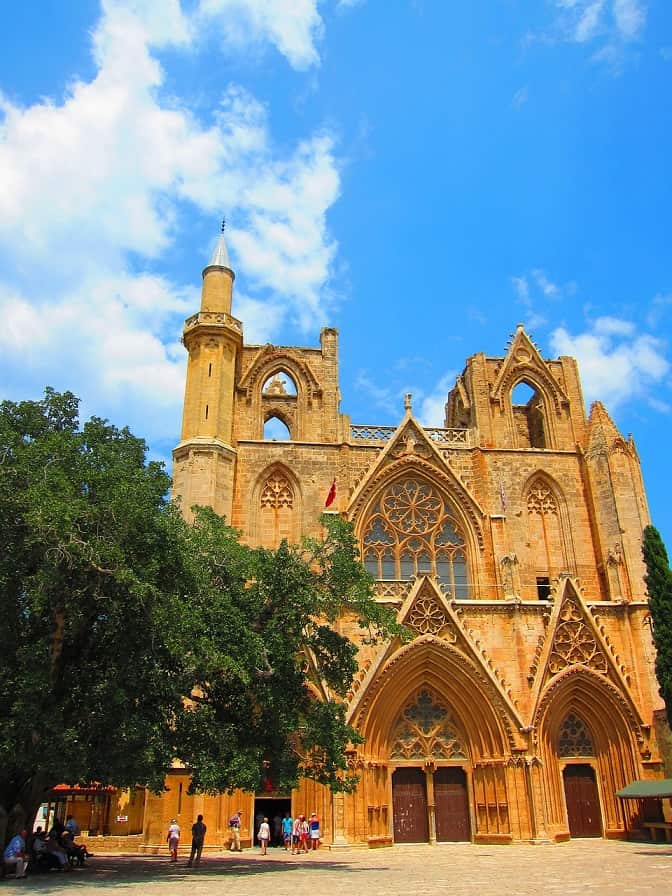
Bellapais Abbey, North Cyprus
Bellapais Abbey is a beautiful medieval monastery in the northern part of Cyprus, near the town of Kyrenia. French Augustinian monks built the monastery in the 13th century. It is one of the finest examples of Gothic architecture in the Mediterranean.
The abbey is an icon due to its stunning architecture, beautiful gardens, and breathtaking views of the surrounding countryside and the Mediterranean Sea. It is also famous for its cultural and historical significance, having been the site of numerous important events throughout Cyprus’s long and turbulent history.
Visitors can explore the abbey’s impressive cloisters and admire its intricate stonework and frescoes. And you can learn about its fascinating history through informative exhibits and tours.

Tours Of Northern Cyprus
If you are not comfortable exploring the north of Cyprus on your own. Or, if you are staying in the South of Cyprus, there are plenty of tour operators with amazing itinerates to choose from:
St. Hilarion Castle, North Cyprus
St. Hilarion Castle is a medieval castle on the Kyrenia mountain range in Northern Cyprus. It is one of the three famous castles of the Byzantines to protect the island against Arab raids. The other two castles are Kyrenia Castle and Buffavento Castle.
St. Hilarion Castle was built in the 10th century on the site of an earlier monastery to honor Saint Hilarion, a hermit monk of the area during the 4th century. The Lusignans and Venetians later expanded the castle in the 12th and 15th centuries. The castle is famous for its stunning views of the surrounding landscape. It is also known for preserving its fortifications, including towers, walls, and gates.
Visitors to St. Hilarion Castle can explore the castle’s various levels and rooms, including the Chapel of St. Hilarion, the royal apartments, and the kitchens. The castle is open to the public, with a small admission fee.

Monastery of Apostolos Varnavas, North Cyprus
The Monastery of Apostolos Varnavas is in the village of Peristerona, in the district of Nicosia, Cyprus. This monastery is an important religious site for North Cyprus that attracts many visitors and pilgrims. The name comes from St. Barnabas, one of the first Christian apostles. Historians claim that St. Barnabas brought Christianity to Cyprus in the 1st century AD.
Built in the 18th century on the ruins of an older monastery that was destroyed during the Ottoman period. As such, it has a rich history and is known for its beautiful architecture, including its bell tower and church, built in the shape of a cross. The church has beautiful frescoes and icons depicting scenes from the life of St. Barnabas.
The monastery also houses a museum showcasing many vital artifacts and religious relics, including manuscripts, icons, and vestments. One of the most important relics in the museum is the holy skull of St. Barnabas, which is kept in a special reliquary.
The Monastery of Apostolos Varnavas is an essential center of Orthodox Christianity in Cyprus. It plays a significant role in the spiritual life of the island.

Famagusta Walled City, Northern Cyprus
The Famagusta Walled City is a historic area on North Cyprus’s eastern coast. It is a fortified city built during the medieval period and was an important regional trading center. The Venetians built the city walls in the 15th century, once rulers over the island. The walls’ design protected the city from attacks by the Ottoman Turks and other enemies.
Many important historical buildings and structures are inside the city’s walls, including the Gothic-style St. Nicholas Cathedral. St. Nicholas Cathedral was built in the 14th century and served as the main church of Famagusta during the medieval period.
Other notable landmarks within the city walls include the Lala Mustafa Pasha Mosque, originally built as the Church of St. Nicholas. This church was later converted into a mosque by the Ottomans. Following this, the Venetian Palace was the residence of the Venetian governors of Cyprus.
Unfortunately, the city has been largely abandoned since the Turkish invasion of Cyprus in 1974, and many of its buildings and structures have fallen into disrepair. However, there have been efforts in recent years to restore and preserve the city’s historic landmarks.
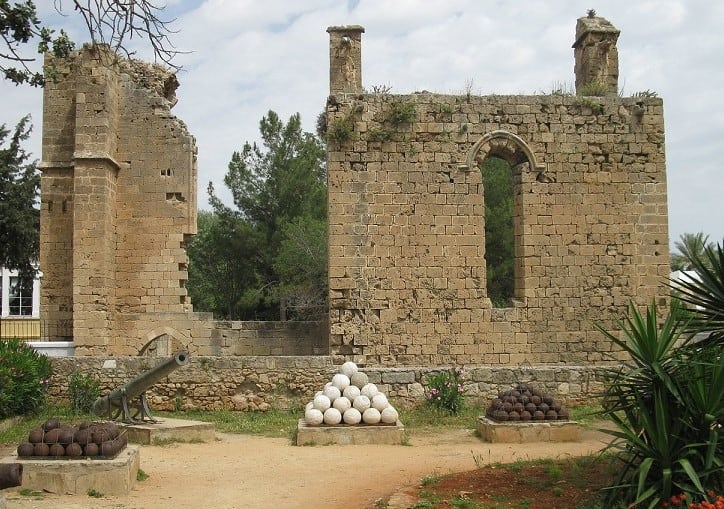
Ancient Salamis, North Cyprus
Ancient Salamis was a city-state on the eastern coast of the island of Cyprus. It was one of the most important and prosperous cities in ancient Cyprus. It played a significant role in the history and culture of the island. Salamis was founded in the 11th century BCE and became the island’s capital during the 7th century BCE. It was an important center for trade and commerce and had a strong military presence due to its strategic location on the eastern coast of Cyprus.
Salamis was also a cultural and artistic center because of its spectacular Roman-era theater, which could seat up to 15,000 people. The city was also home to several important religious sites, including a sanctuary to Zeus and a temple to the goddess Athena.
Throughout its history, Salamis was conquered and ruled by various empires and nations – the Assyrians, Persians, Greeks, Romans, and Byzantines. The city was eventually abandoned in the 7th century CE due to Arab invasions and raids, and its ruins can still be visited today.
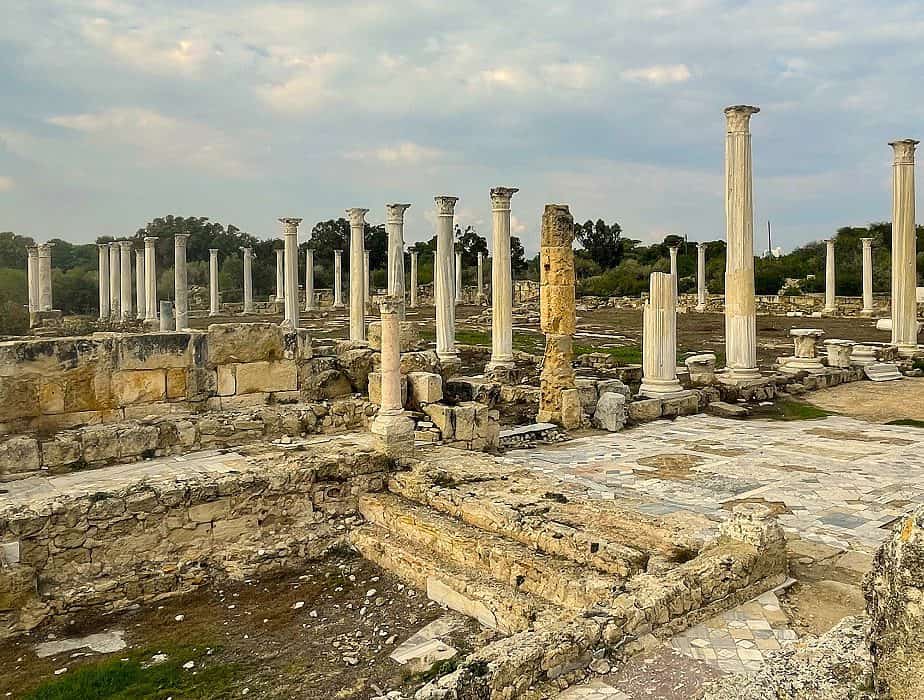
Karpaz Peninsula, North Cyprus
The Karpaz Peninsula is a long, narrow peninsula in the northeastern part of the island of Cyprus. It is known for its rugged natural beauty, unspoiled beaches, and rich history. The peninsula is also home to several important archaeological sites and traditional Cypriot villages.
One of the most famous attractions in the Karpaz Peninsula is Golden Beach, considered one of the most beautiful beaches in the Mediterranean. This long stretch of white sand and crystal-clear water is a popular destination for swimmers, sunbathers, and water sports enthusiasts.
The Karpaz Peninsula is also home to the Karpaz National Park, which covers an area of over 50,000 hectares and includes a diverse range of habitats, including forests, wetlands, and coastal regions. The park has various flora and fauna, including several endangered species.
The peninsula is also rich in history, with numerous ancient ruins and monuments scattered throughout the area. Some of the most notable include the ancient city of Aphendrika, the Byzantine Monastery of Apostolos Andreas ruins, and the ancient city of Karpasia.
The Karpaz Peninsula is a relatively untouched and unspoiled part of Northern Cyprus, making it a popular destination for those looking to escape the crowds and enjoy the island’s natural beauty.

Kantara Castle, Northern Cyprus
Kantara Castle is a medieval castle in the eastern part of Northern Cyprus. It sits on a hill at an altitude of 630 meters above sea level, near the village of Kantara in the district of Famagusta. The castle was built during the Byzantine period and was later home to the Lusignans, Venetians, and Ottomans.
The castle was initially built as a defensive fortification to protect the region from Arab raids. It was strategically located on a hilltop overlooking the northern coastline, providing a clear view of the surrounding area. The castle was made larger and stronger during the Lusignan period in the 13th century.
Kantara Castle is a central keep surrounded by a double wall with several towers and bastions. The castle also has a cistern for water storage and a chapel dedicated to St. Hilarion. The castle’s location and design made it a formidable stronghold and played an essential role in defending the region against invaders.
Today, Kantara Castle is a popular tourist attraction for the public. It offers visitors stunning views of the surrounding countryside and the coastline. The castle is also an important historic site, providing a glimpse into the island’s rich and diverse history.

Buffavento Castle, North Cyprus
Buffavento Castle is a medieval castle located on the top of a mountain in Northern Cyprus, near Kyrenia. The Byzantines built the castle in the 10th century as a defensive fortress to protect against Arab raids.
The castle was later rebuilt by the Lusignans in the 14th century and then by the Venetians in the 16th century. During its history, Buffavento Castle played an essential role in the island’s defense against various invaders, including the Ottomans.
Buffavento Castle is a popular tourist destination today due to its stunning views of the mountains and coastline. However, the castle is in a state of ruin, and visitors must climb a steep path to reach it. Visitors to Buffavento Castle can explore the remains of the castle’s walls, towers, and chapels. They can also take in the panoramic views of the island and the Mediterranean Sea from the castle’s highest point, over 950 meters above sea level.
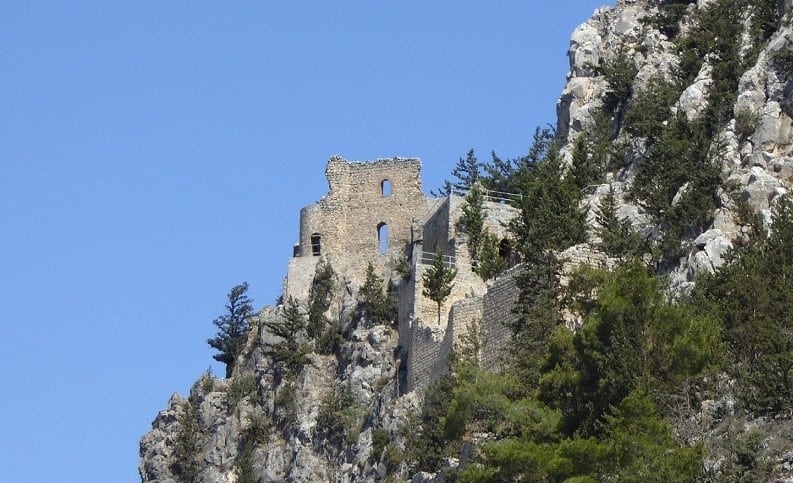
Nicosia Old City, North Cyprus
Nicosia Old City, also known as the walled city of Nicosia, is located in the northern part of Cyprus and is the capital city of the self-declared Turkish Republic of Northern Cyprus. A 16th-century Venetian wall surrounds the old city, and its narrow streets are lined with historic buildings and monuments.
One of the most notable landmarks in the old city is the Selimiye Mosque, built initially as the Cathedral of Saint Sophia during the Lusignan period in the 13th century. The mosque has a distinctive double minaret and is considered one of the finest examples of Gothic architecture in the Eastern Mediterranean.
Other notable landmarks in the old city include the Buyuk Han, a restored Ottoman-era inn serving as a cultural center and marketplace, and the Bedesten, an indoor bazaar that dates back to the 16th century. Visitors to the old city can also explore several museums, including the Cyprus Museum of Modern Arts and the Mevlevi Tekke Museum, which showcases the traditions and history of the Mevlevi Order of Sufism.
Nicosia Old City is also known for its lively atmosphere and bustling street life, with a wide variety of shops, cafes, and restaurants lining its streets. The old city is particularly popular with tourists interested in history and culture, and many visitors spend several days exploring its narrow streets and historical landmarks.
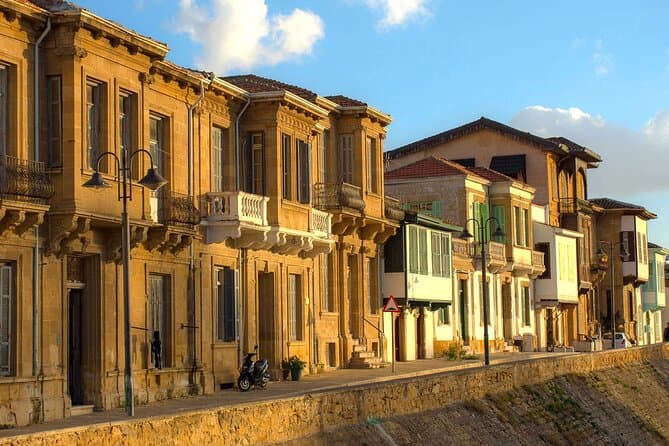
Vouni Palace (Palace of Vouni), Northern Cyprus
Vouni Palace is an archaeological site in the northern part of Cyprus, near the town of Guzelyurt. Built during the 5th century BC by the Persians and was the later residence of the Greeks and Romans.
The palace rests on a hilltop overlooking the Mediterranean Sea. The limestone blocks used to construct it are still visible. The site covers an area of approximately 2,500 square meters. Historians believe it served as a residence for the region’s ruling elite.
Excavations at the site have revealed several rooms, including a central courtyard, a throne room, a reception hall, and private living quarters. There are also remains of a large cistern and a complex system of water channels.
The palace was left in the 4th century AD. It was rediscovery in the early 20th century. Today, the site is open to the public, and visitors can explore the ruins and learn about the history and culture of ancient Cyprus.

Closing Thoughts
Northern Cyprus is a fantastic place to visit. Not only is there plenty to see and do, but it is also not a tourist haven. If you head here for the beaches, you will have them to yourself.
Visiting Cyprus? Let us know where you explore!
Looking for more posts on Cyprus? Start here:
- 20 Plus Things to Do in Cyprus
- Adonis Baths Waterfall in Cyprus
- Ancient Kourion: Cyprus’ House of Eustolios
- Ancient Salamis – The City Of Ruins In Famagusta
- Can You Fly to North Cyprus?
- Cyprus Border Crossing Between North and South Cyprus
- Kolossi Castle in Cyprus – A Hidden Gem
We participate in the Amazon Services LLC Associates Program, an affiliate advertising program designed to provide a means for us to earn fees by linking to Amazon.com and affiliated sites.
Brit On The Move™ Travel Resources
Ready to book your next trip? Use these resources that work:
Was the flight canceled or delayed? Find out if you are eligible for compensation with AirHelp.
- Book your Hotel: Find the best prices; use Booking.com
- Find Apartment Rentals: You will find the best prices on apartment rentals with Booking.com’s Apartment Finder.
- Travel Insurance: Don’t leave home without it. View our suggestions to help you decide which travel insurance is for you: Travel Insurance Guide.
- Want to earn tons of points and make your next trip accessible? Check out our recommendations for Travel Credit Cards.
- Want To Take A Volunteer Vacation or a Working Holiday? Check out the complete guide to how here!
- Want to Shop For Travel Accessories? Check out our Travel Shop.
Need more help planning your trip? Visit our Resources Page, which highlights the great companies we use for traveling.
Yet the people are racist and very greedy.
Wow, Tom, that’s a tad harsh… there are terrible people everywhere but I didn’t experience anything overt in North Cyprus. Nikki